Effectiveness of Ursula Burns' Leadership Style in Transforming Xerox Culture
VerifiedAdded on 2019/10/31
|12
|2840
|17
Report
AI Summary
The assignment content is about Ursula Burns, the first African American woman to lead a Fortune 500 company as CEO of Xerox Corporation. She brought significant changes to the organization by embracing frankness and risk-taking, transforming the culture from 'terminal niceness' to open, honest, and decisive decision-making. Her leadership style was missionary, encouraging employees to perform well and giving them positive motivation. She focused on innovation and inculcated a sense of responsibility among her employees, which led to productivity and sustainable business. The organization's diversity and community engagement helped manage and sustain the change.
Contribute Materials
Your contribution can guide someone’s learning journey. Share your
documents today.
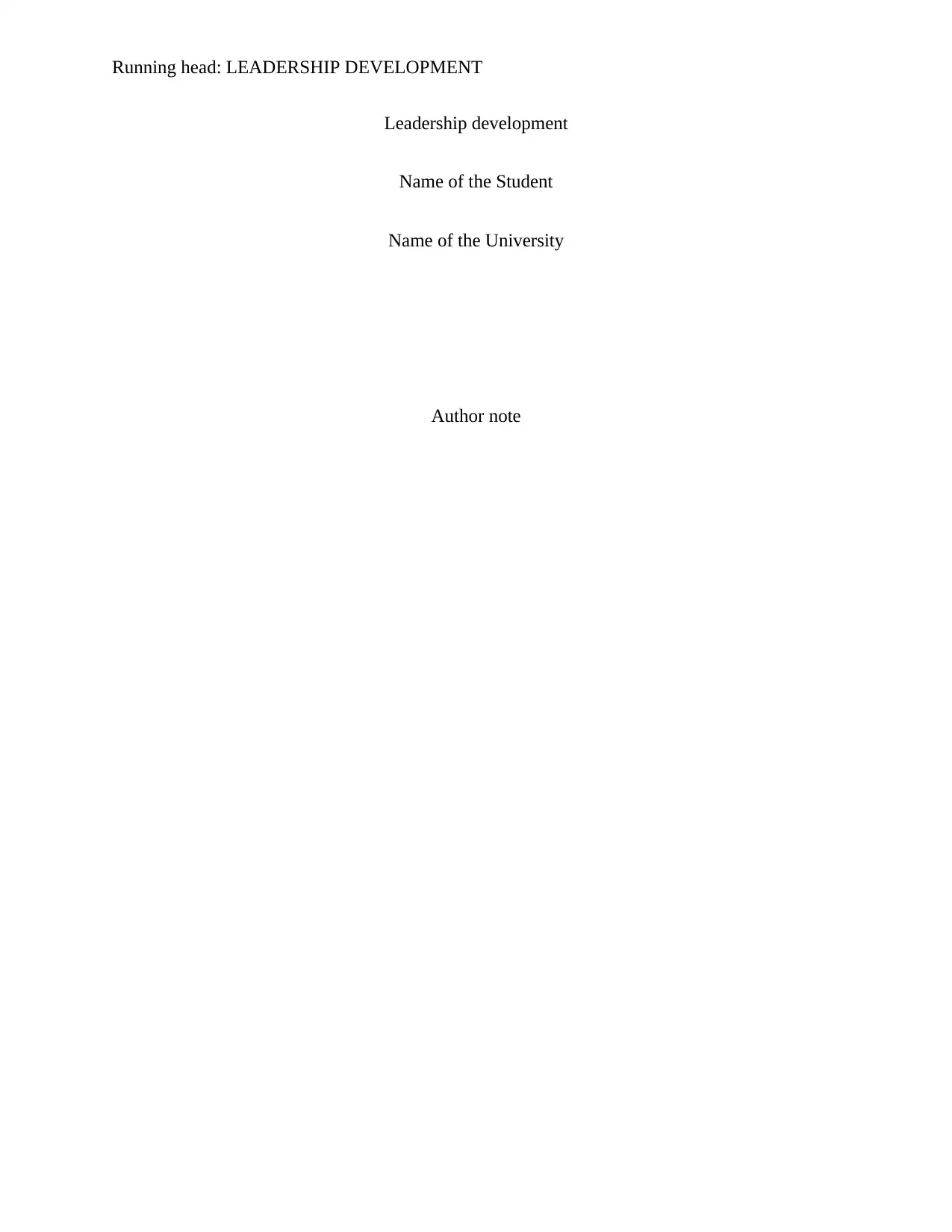
Running head: LEADERSHIP DEVELOPMENT
Leadership development
Name of the Student
Name of the University
Author note
Leadership development
Name of the Student
Name of the University
Author note
Secure Best Marks with AI Grader
Need help grading? Try our AI Grader for instant feedback on your assignments.
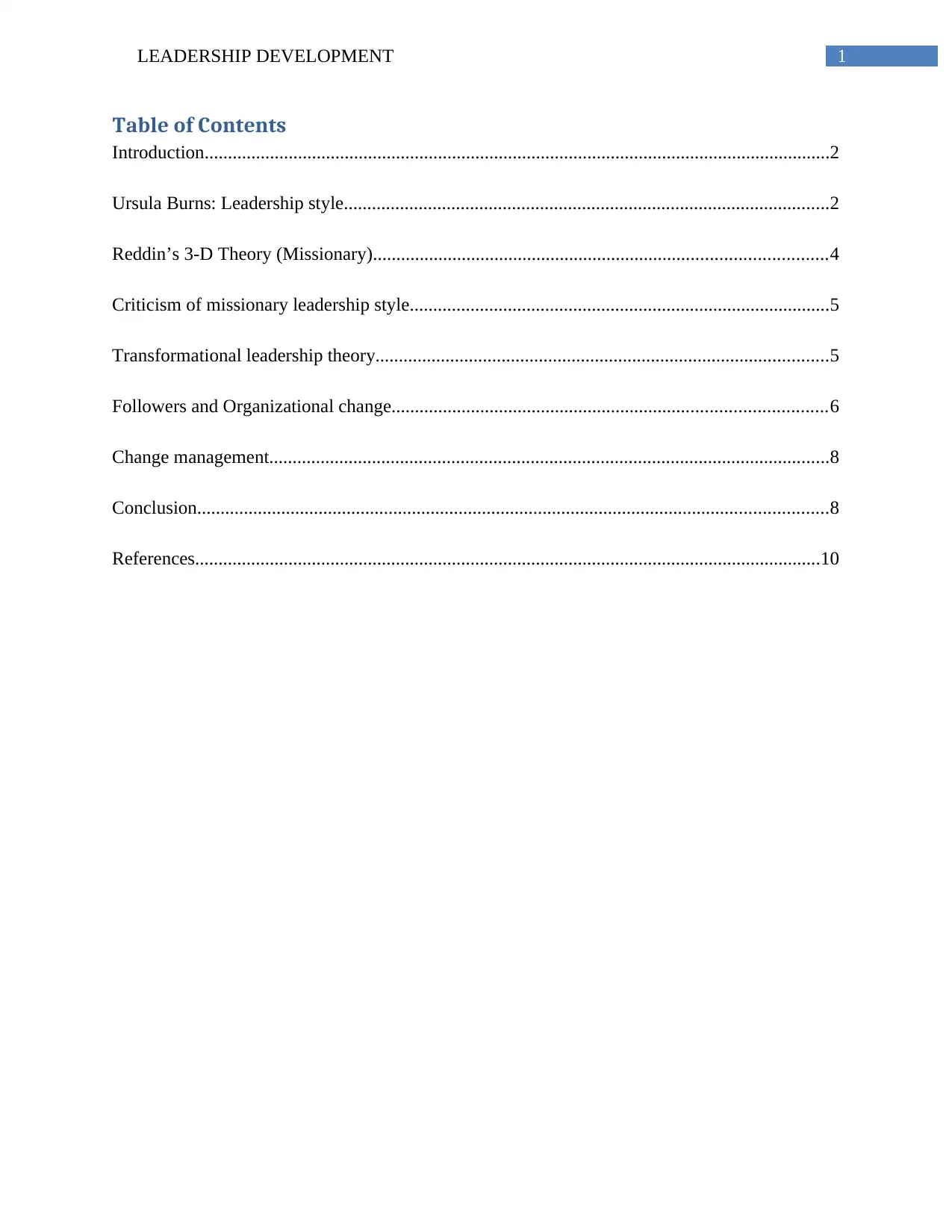
1LEADERSHIP DEVELOPMENT
Table of Contents
Introduction......................................................................................................................................2
Ursula Burns: Leadership style........................................................................................................2
Reddin’s 3-D Theory (Missionary).................................................................................................4
Criticism of missionary leadership style..........................................................................................5
Transformational leadership theory.................................................................................................5
Followers and Organizational change.............................................................................................6
Change management........................................................................................................................8
Conclusion.......................................................................................................................................8
References......................................................................................................................................10
Table of Contents
Introduction......................................................................................................................................2
Ursula Burns: Leadership style........................................................................................................2
Reddin’s 3-D Theory (Missionary).................................................................................................4
Criticism of missionary leadership style..........................................................................................5
Transformational leadership theory.................................................................................................5
Followers and Organizational change.............................................................................................6
Change management........................................................................................................................8
Conclusion.......................................................................................................................................8
References......................................................................................................................................10
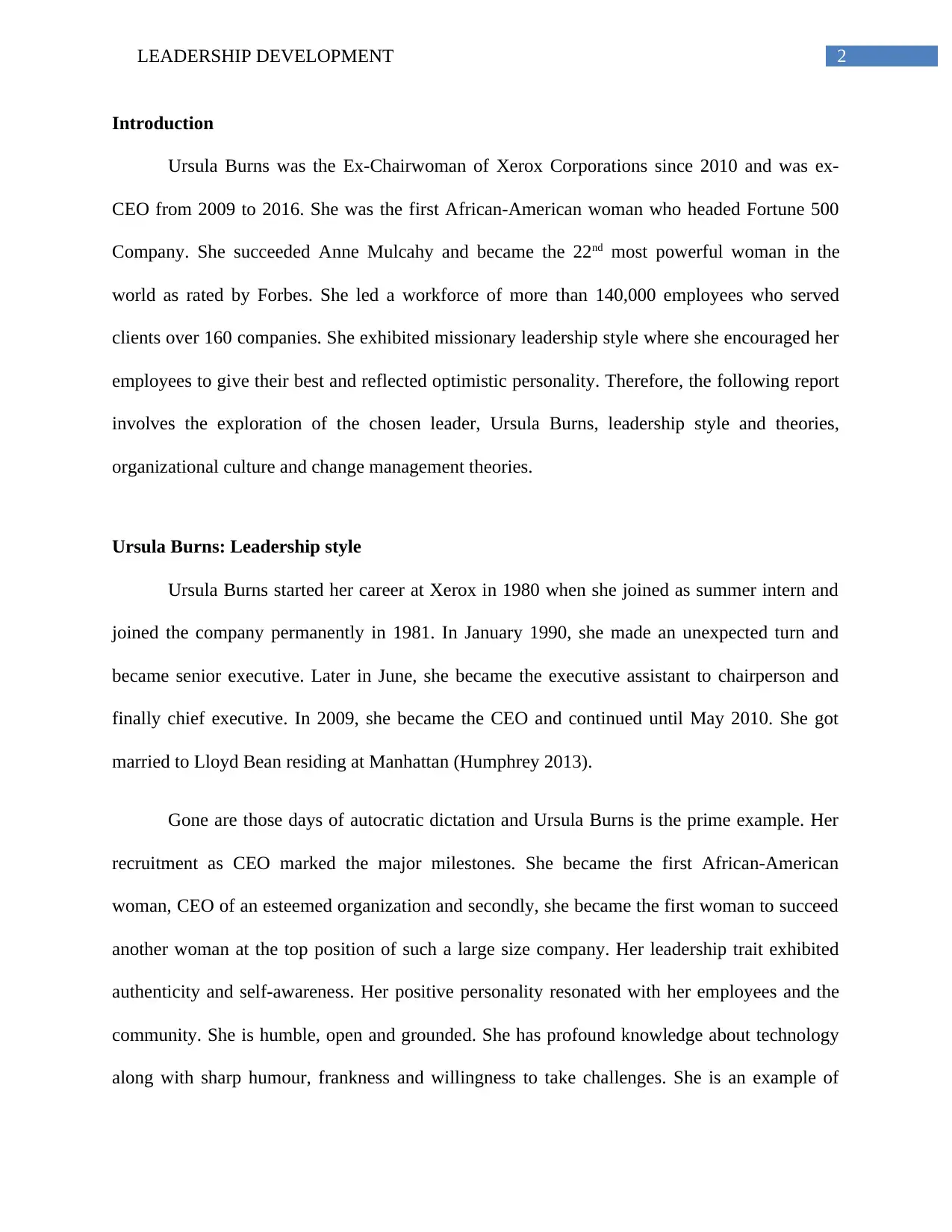
2LEADERSHIP DEVELOPMENT
Introduction
Ursula Burns was the Ex-Chairwoman of Xerox Corporations since 2010 and was ex-
CEO from 2009 to 2016. She was the first African-American woman who headed Fortune 500
Company. She succeeded Anne Mulcahy and became the 22nd most powerful woman in the
world as rated by Forbes. She led a workforce of more than 140,000 employees who served
clients over 160 companies. She exhibited missionary leadership style where she encouraged her
employees to give their best and reflected optimistic personality. Therefore, the following report
involves the exploration of the chosen leader, Ursula Burns, leadership style and theories,
organizational culture and change management theories.
Ursula Burns: Leadership style
Ursula Burns started her career at Xerox in 1980 when she joined as summer intern and
joined the company permanently in 1981. In January 1990, she made an unexpected turn and
became senior executive. Later in June, she became the executive assistant to chairperson and
finally chief executive. In 2009, she became the CEO and continued until May 2010. She got
married to Lloyd Bean residing at Manhattan (Humphrey 2013).
Gone are those days of autocratic dictation and Ursula Burns is the prime example. Her
recruitment as CEO marked the major milestones. She became the first African-American
woman, CEO of an esteemed organization and secondly, she became the first woman to succeed
another woman at the top position of such a large size company. Her leadership trait exhibited
authenticity and self-awareness. Her positive personality resonated with her employees and the
community. She is humble, open and grounded. She has profound knowledge about technology
along with sharp humour, frankness and willingness to take challenges. She is an example of
Introduction
Ursula Burns was the Ex-Chairwoman of Xerox Corporations since 2010 and was ex-
CEO from 2009 to 2016. She was the first African-American woman who headed Fortune 500
Company. She succeeded Anne Mulcahy and became the 22nd most powerful woman in the
world as rated by Forbes. She led a workforce of more than 140,000 employees who served
clients over 160 companies. She exhibited missionary leadership style where she encouraged her
employees to give their best and reflected optimistic personality. Therefore, the following report
involves the exploration of the chosen leader, Ursula Burns, leadership style and theories,
organizational culture and change management theories.
Ursula Burns: Leadership style
Ursula Burns started her career at Xerox in 1980 when she joined as summer intern and
joined the company permanently in 1981. In January 1990, she made an unexpected turn and
became senior executive. Later in June, she became the executive assistant to chairperson and
finally chief executive. In 2009, she became the CEO and continued until May 2010. She got
married to Lloyd Bean residing at Manhattan (Humphrey 2013).
Gone are those days of autocratic dictation and Ursula Burns is the prime example. Her
recruitment as CEO marked the major milestones. She became the first African-American
woman, CEO of an esteemed organization and secondly, she became the first woman to succeed
another woman at the top position of such a large size company. Her leadership trait exhibited
authenticity and self-awareness. Her positive personality resonated with her employees and the
community. She is humble, open and grounded. She has profound knowledge about technology
along with sharp humour, frankness and willingness to take challenges. She is an example of
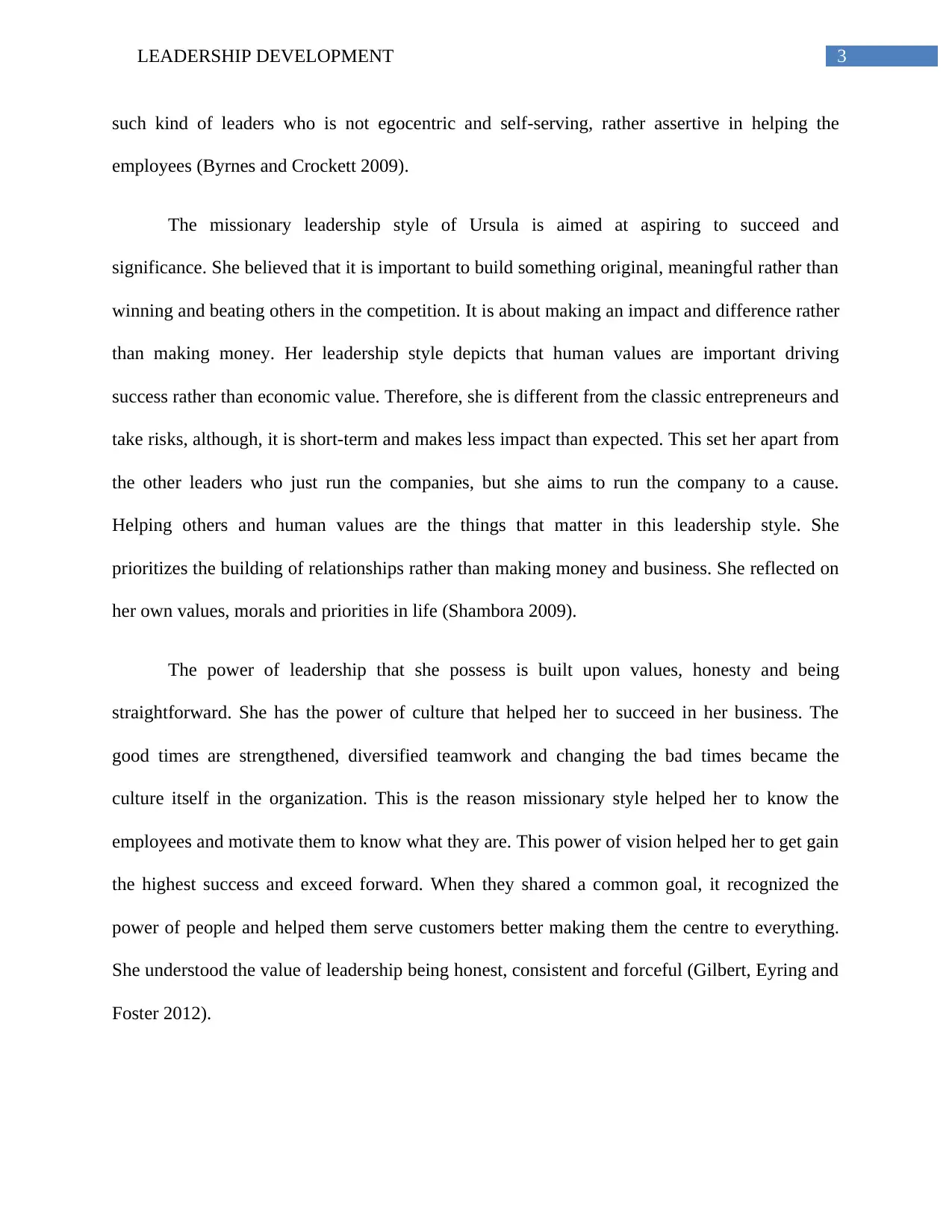
3LEADERSHIP DEVELOPMENT
such kind of leaders who is not egocentric and self-serving, rather assertive in helping the
employees (Byrnes and Crockett 2009).
The missionary leadership style of Ursula is aimed at aspiring to succeed and
significance. She believed that it is important to build something original, meaningful rather than
winning and beating others in the competition. It is about making an impact and difference rather
than making money. Her leadership style depicts that human values are important driving
success rather than economic value. Therefore, she is different from the classic entrepreneurs and
take risks, although, it is short-term and makes less impact than expected. This set her apart from
the other leaders who just run the companies, but she aims to run the company to a cause.
Helping others and human values are the things that matter in this leadership style. She
prioritizes the building of relationships rather than making money and business. She reflected on
her own values, morals and priorities in life (Shambora 2009).
The power of leadership that she possess is built upon values, honesty and being
straightforward. She has the power of culture that helped her to succeed in her business. The
good times are strengthened, diversified teamwork and changing the bad times became the
culture itself in the organization. This is the reason missionary style helped her to know the
employees and motivate them to know what they are. This power of vision helped her to get gain
the highest success and exceed forward. When they shared a common goal, it recognized the
power of people and helped them serve customers better making them the centre to everything.
She understood the value of leadership being honest, consistent and forceful (Gilbert, Eyring and
Foster 2012).
such kind of leaders who is not egocentric and self-serving, rather assertive in helping the
employees (Byrnes and Crockett 2009).
The missionary leadership style of Ursula is aimed at aspiring to succeed and
significance. She believed that it is important to build something original, meaningful rather than
winning and beating others in the competition. It is about making an impact and difference rather
than making money. Her leadership style depicts that human values are important driving
success rather than economic value. Therefore, she is different from the classic entrepreneurs and
take risks, although, it is short-term and makes less impact than expected. This set her apart from
the other leaders who just run the companies, but she aims to run the company to a cause.
Helping others and human values are the things that matter in this leadership style. She
prioritizes the building of relationships rather than making money and business. She reflected on
her own values, morals and priorities in life (Shambora 2009).
The power of leadership that she possess is built upon values, honesty and being
straightforward. She has the power of culture that helped her to succeed in her business. The
good times are strengthened, diversified teamwork and changing the bad times became the
culture itself in the organization. This is the reason missionary style helped her to know the
employees and motivate them to know what they are. This power of vision helped her to get gain
the highest success and exceed forward. When they shared a common goal, it recognized the
power of people and helped them serve customers better making them the centre to everything.
She understood the value of leadership being honest, consistent and forceful (Gilbert, Eyring and
Foster 2012).
Secure Best Marks with AI Grader
Need help grading? Try our AI Grader for instant feedback on your assignments.
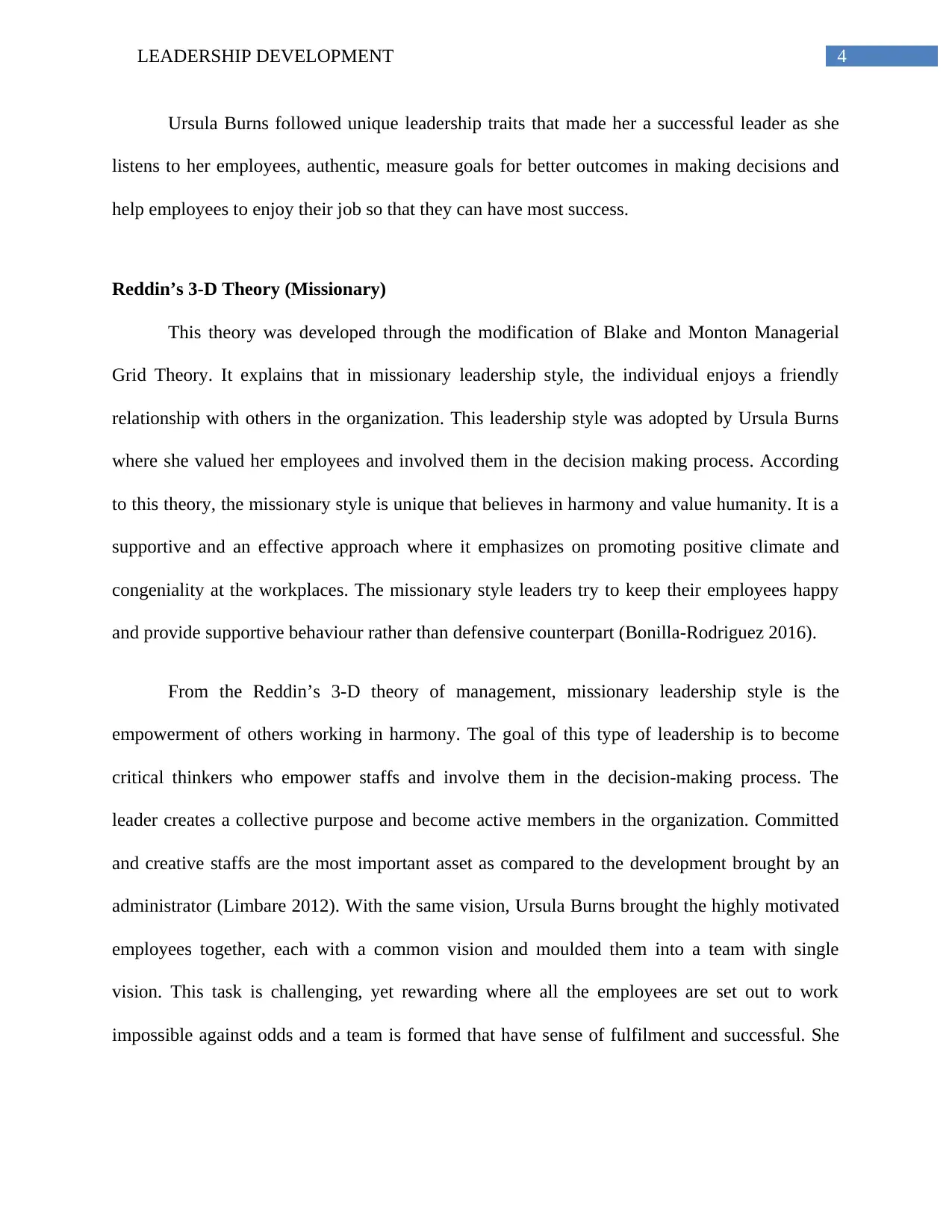
4LEADERSHIP DEVELOPMENT
Ursula Burns followed unique leadership traits that made her a successful leader as she
listens to her employees, authentic, measure goals for better outcomes in making decisions and
help employees to enjoy their job so that they can have most success.
Reddin’s 3-D Theory (Missionary)
This theory was developed through the modification of Blake and Monton Managerial
Grid Theory. It explains that in missionary leadership style, the individual enjoys a friendly
relationship with others in the organization. This leadership style was adopted by Ursula Burns
where she valued her employees and involved them in the decision making process. According
to this theory, the missionary style is unique that believes in harmony and value humanity. It is a
supportive and an effective approach where it emphasizes on promoting positive climate and
congeniality at the workplaces. The missionary style leaders try to keep their employees happy
and provide supportive behaviour rather than defensive counterpart (Bonilla-Rodriguez 2016).
From the Reddin’s 3-D theory of management, missionary leadership style is the
empowerment of others working in harmony. The goal of this type of leadership is to become
critical thinkers who empower staffs and involve them in the decision-making process. The
leader creates a collective purpose and become active members in the organization. Committed
and creative staffs are the most important asset as compared to the development brought by an
administrator (Limbare 2012). With the same vision, Ursula Burns brought the highly motivated
employees together, each with a common vision and moulded them into a team with single
vision. This task is challenging, yet rewarding where all the employees are set out to work
impossible against odds and a team is formed that have sense of fulfilment and successful. She
Ursula Burns followed unique leadership traits that made her a successful leader as she
listens to her employees, authentic, measure goals for better outcomes in making decisions and
help employees to enjoy their job so that they can have most success.
Reddin’s 3-D Theory (Missionary)
This theory was developed through the modification of Blake and Monton Managerial
Grid Theory. It explains that in missionary leadership style, the individual enjoys a friendly
relationship with others in the organization. This leadership style was adopted by Ursula Burns
where she valued her employees and involved them in the decision making process. According
to this theory, the missionary style is unique that believes in harmony and value humanity. It is a
supportive and an effective approach where it emphasizes on promoting positive climate and
congeniality at the workplaces. The missionary style leaders try to keep their employees happy
and provide supportive behaviour rather than defensive counterpart (Bonilla-Rodriguez 2016).
From the Reddin’s 3-D theory of management, missionary leadership style is the
empowerment of others working in harmony. The goal of this type of leadership is to become
critical thinkers who empower staffs and involve them in the decision-making process. The
leader creates a collective purpose and become active members in the organization. Committed
and creative staffs are the most important asset as compared to the development brought by an
administrator (Limbare 2012). With the same vision, Ursula Burns brought the highly motivated
employees together, each with a common vision and moulded them into a team with single
vision. This task is challenging, yet rewarding where all the employees are set out to work
impossible against odds and a team is formed that have sense of fulfilment and successful. She
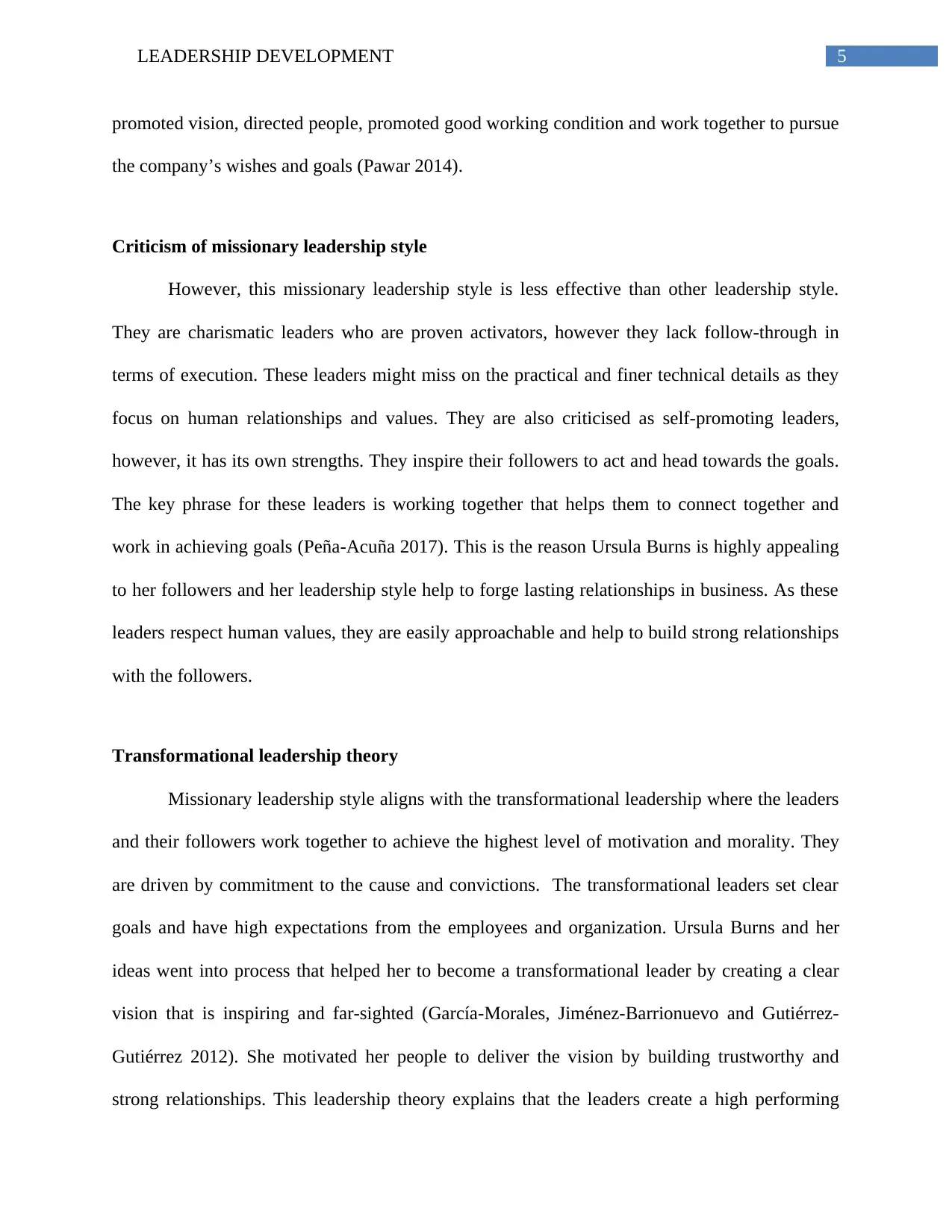
5LEADERSHIP DEVELOPMENT
promoted vision, directed people, promoted good working condition and work together to pursue
the company’s wishes and goals (Pawar 2014).
Criticism of missionary leadership style
However, this missionary leadership style is less effective than other leadership style.
They are charismatic leaders who are proven activators, however they lack follow-through in
terms of execution. These leaders might miss on the practical and finer technical details as they
focus on human relationships and values. They are also criticised as self-promoting leaders,
however, it has its own strengths. They inspire their followers to act and head towards the goals.
The key phrase for these leaders is working together that helps them to connect together and
work in achieving goals (Peña-Acuña 2017). This is the reason Ursula Burns is highly appealing
to her followers and her leadership style help to forge lasting relationships in business. As these
leaders respect human values, they are easily approachable and help to build strong relationships
with the followers.
Transformational leadership theory
Missionary leadership style aligns with the transformational leadership where the leaders
and their followers work together to achieve the highest level of motivation and morality. They
are driven by commitment to the cause and convictions. The transformational leaders set clear
goals and have high expectations from the employees and organization. Ursula Burns and her
ideas went into process that helped her to become a transformational leader by creating a clear
vision that is inspiring and far-sighted (García-Morales, Jiménez-Barrionuevo and Gutiérrez-
Gutiérrez 2012). She motivated her people to deliver the vision by building trustworthy and
strong relationships. This leadership theory explains that the leaders create a high performing
promoted vision, directed people, promoted good working condition and work together to pursue
the company’s wishes and goals (Pawar 2014).
Criticism of missionary leadership style
However, this missionary leadership style is less effective than other leadership style.
They are charismatic leaders who are proven activators, however they lack follow-through in
terms of execution. These leaders might miss on the practical and finer technical details as they
focus on human relationships and values. They are also criticised as self-promoting leaders,
however, it has its own strengths. They inspire their followers to act and head towards the goals.
The key phrase for these leaders is working together that helps them to connect together and
work in achieving goals (Peña-Acuña 2017). This is the reason Ursula Burns is highly appealing
to her followers and her leadership style help to forge lasting relationships in business. As these
leaders respect human values, they are easily approachable and help to build strong relationships
with the followers.
Transformational leadership theory
Missionary leadership style aligns with the transformational leadership where the leaders
and their followers work together to achieve the highest level of motivation and morality. They
are driven by commitment to the cause and convictions. The transformational leaders set clear
goals and have high expectations from the employees and organization. Ursula Burns and her
ideas went into process that helped her to become a transformational leader by creating a clear
vision that is inspiring and far-sighted (García-Morales, Jiménez-Barrionuevo and Gutiérrez-
Gutiérrez 2012). She motivated her people to deliver the vision by building trustworthy and
strong relationships. This leadership theory explains that the leaders create a high performing
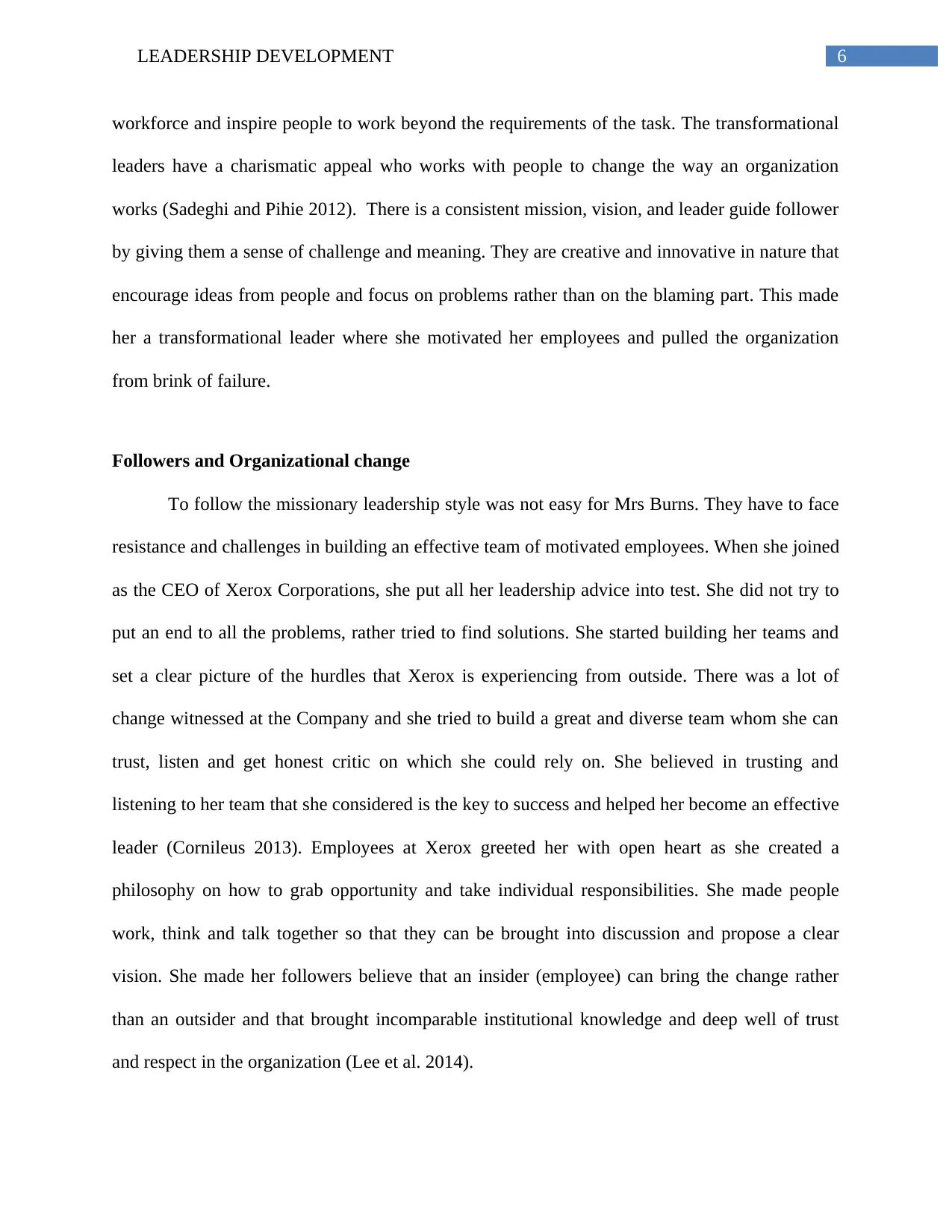
6LEADERSHIP DEVELOPMENT
workforce and inspire people to work beyond the requirements of the task. The transformational
leaders have a charismatic appeal who works with people to change the way an organization
works (Sadeghi and Pihie 2012). There is a consistent mission, vision, and leader guide follower
by giving them a sense of challenge and meaning. They are creative and innovative in nature that
encourage ideas from people and focus on problems rather than on the blaming part. This made
her a transformational leader where she motivated her employees and pulled the organization
from brink of failure.
Followers and Organizational change
To follow the missionary leadership style was not easy for Mrs Burns. They have to face
resistance and challenges in building an effective team of motivated employees. When she joined
as the CEO of Xerox Corporations, she put all her leadership advice into test. She did not try to
put an end to all the problems, rather tried to find solutions. She started building her teams and
set a clear picture of the hurdles that Xerox is experiencing from outside. There was a lot of
change witnessed at the Company and she tried to build a great and diverse team whom she can
trust, listen and get honest critic on which she could rely on. She believed in trusting and
listening to her team that she considered is the key to success and helped her become an effective
leader (Cornileus 2013). Employees at Xerox greeted her with open heart as she created a
philosophy on how to grab opportunity and take individual responsibilities. She made people
work, think and talk together so that they can be brought into discussion and propose a clear
vision. She made her followers believe that an insider (employee) can bring the change rather
than an outsider and that brought incomparable institutional knowledge and deep well of trust
and respect in the organization (Lee et al. 2014).
workforce and inspire people to work beyond the requirements of the task. The transformational
leaders have a charismatic appeal who works with people to change the way an organization
works (Sadeghi and Pihie 2012). There is a consistent mission, vision, and leader guide follower
by giving them a sense of challenge and meaning. They are creative and innovative in nature that
encourage ideas from people and focus on problems rather than on the blaming part. This made
her a transformational leader where she motivated her employees and pulled the organization
from brink of failure.
Followers and Organizational change
To follow the missionary leadership style was not easy for Mrs Burns. They have to face
resistance and challenges in building an effective team of motivated employees. When she joined
as the CEO of Xerox Corporations, she put all her leadership advice into test. She did not try to
put an end to all the problems, rather tried to find solutions. She started building her teams and
set a clear picture of the hurdles that Xerox is experiencing from outside. There was a lot of
change witnessed at the Company and she tried to build a great and diverse team whom she can
trust, listen and get honest critic on which she could rely on. She believed in trusting and
listening to her team that she considered is the key to success and helped her become an effective
leader (Cornileus 2013). Employees at Xerox greeted her with open heart as she created a
philosophy on how to grab opportunity and take individual responsibilities. She made people
work, think and talk together so that they can be brought into discussion and propose a clear
vision. She made her followers believe that an insider (employee) can bring the change rather
than an outsider and that brought incomparable institutional knowledge and deep well of trust
and respect in the organization (Lee et al. 2014).
Paraphrase This Document
Need a fresh take? Get an instant paraphrase of this document with our AI Paraphraser
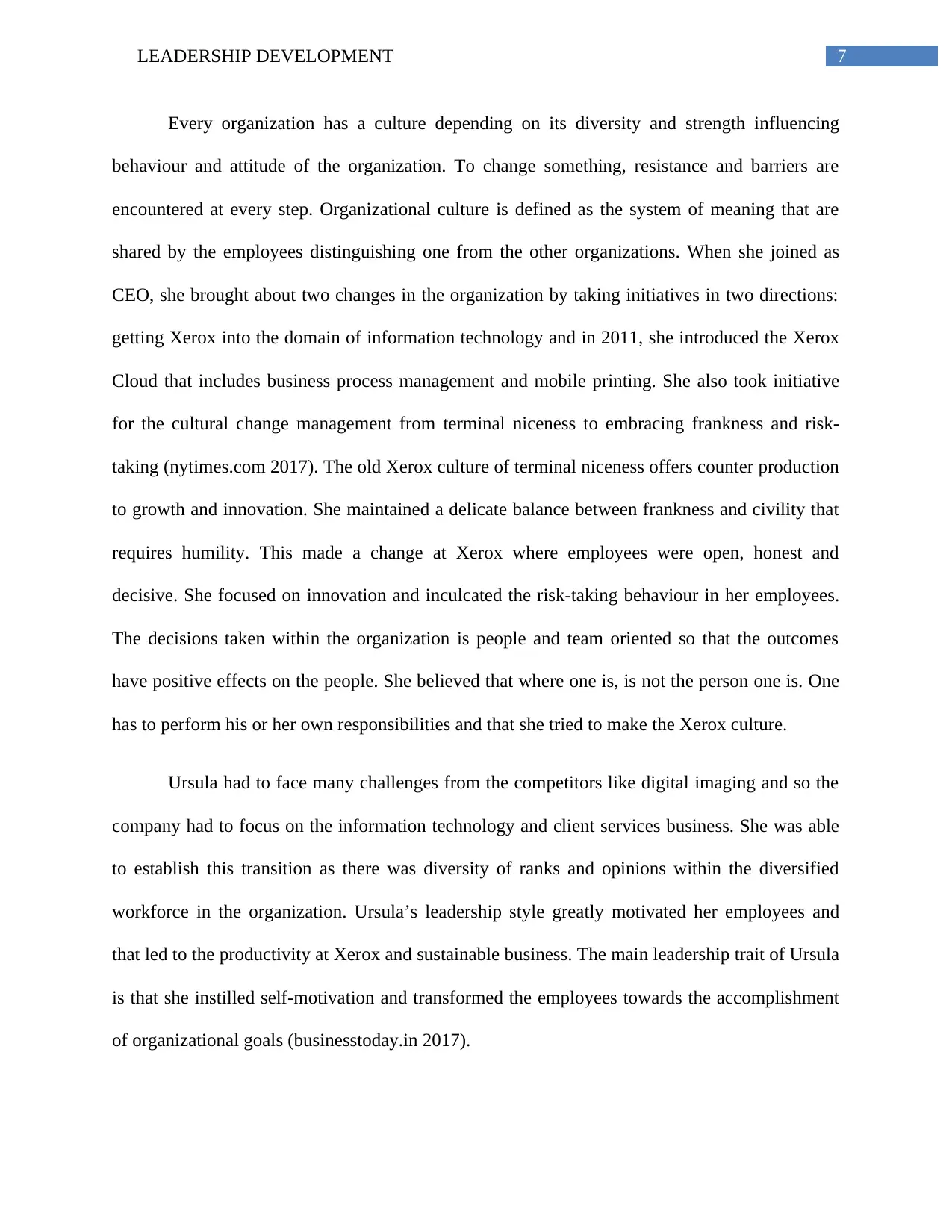
7LEADERSHIP DEVELOPMENT
Every organization has a culture depending on its diversity and strength influencing
behaviour and attitude of the organization. To change something, resistance and barriers are
encountered at every step. Organizational culture is defined as the system of meaning that are
shared by the employees distinguishing one from the other organizations. When she joined as
CEO, she brought about two changes in the organization by taking initiatives in two directions:
getting Xerox into the domain of information technology and in 2011, she introduced the Xerox
Cloud that includes business process management and mobile printing. She also took initiative
for the cultural change management from terminal niceness to embracing frankness and risk-
taking (nytimes.com 2017). The old Xerox culture of terminal niceness offers counter production
to growth and innovation. She maintained a delicate balance between frankness and civility that
requires humility. This made a change at Xerox where employees were open, honest and
decisive. She focused on innovation and inculcated the risk-taking behaviour in her employees.
The decisions taken within the organization is people and team oriented so that the outcomes
have positive effects on the people. She believed that where one is, is not the person one is. One
has to perform his or her own responsibilities and that she tried to make the Xerox culture.
Ursula had to face many challenges from the competitors like digital imaging and so the
company had to focus on the information technology and client services business. She was able
to establish this transition as there was diversity of ranks and opinions within the diversified
workforce in the organization. Ursula’s leadership style greatly motivated her employees and
that led to the productivity at Xerox and sustainable business. The main leadership trait of Ursula
is that she instilled self-motivation and transformed the employees towards the accomplishment
of organizational goals (businesstoday.in 2017).
Every organization has a culture depending on its diversity and strength influencing
behaviour and attitude of the organization. To change something, resistance and barriers are
encountered at every step. Organizational culture is defined as the system of meaning that are
shared by the employees distinguishing one from the other organizations. When she joined as
CEO, she brought about two changes in the organization by taking initiatives in two directions:
getting Xerox into the domain of information technology and in 2011, she introduced the Xerox
Cloud that includes business process management and mobile printing. She also took initiative
for the cultural change management from terminal niceness to embracing frankness and risk-
taking (nytimes.com 2017). The old Xerox culture of terminal niceness offers counter production
to growth and innovation. She maintained a delicate balance between frankness and civility that
requires humility. This made a change at Xerox where employees were open, honest and
decisive. She focused on innovation and inculcated the risk-taking behaviour in her employees.
The decisions taken within the organization is people and team oriented so that the outcomes
have positive effects on the people. She believed that where one is, is not the person one is. One
has to perform his or her own responsibilities and that she tried to make the Xerox culture.
Ursula had to face many challenges from the competitors like digital imaging and so the
company had to focus on the information technology and client services business. She was able
to establish this transition as there was diversity of ranks and opinions within the diversified
workforce in the organization. Ursula’s leadership style greatly motivated her employees and
that led to the productivity at Xerox and sustainable business. The main leadership trait of Ursula
is that she instilled self-motivation and transformed the employees towards the accomplishment
of organizational goals (businesstoday.in 2017).
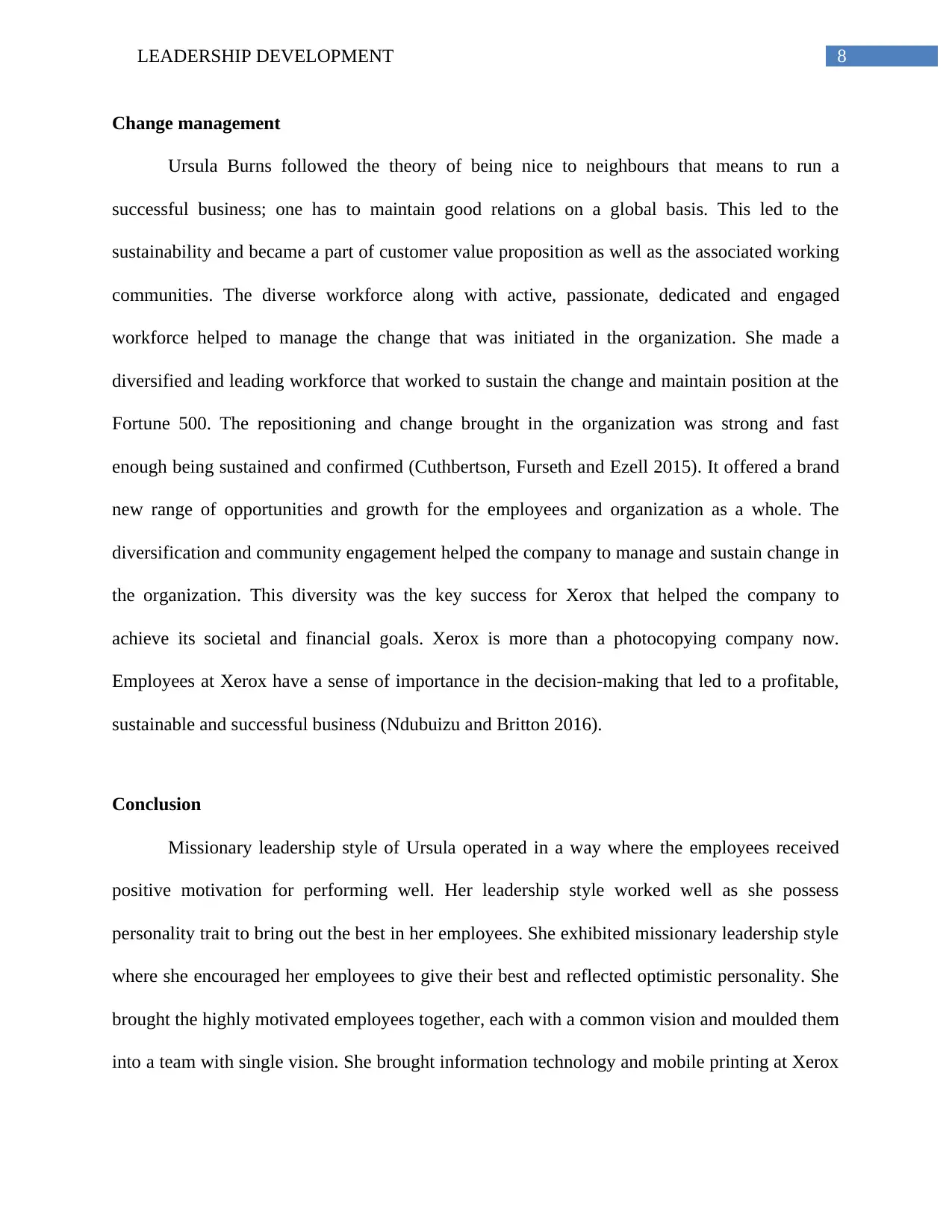
8LEADERSHIP DEVELOPMENT
Change management
Ursula Burns followed the theory of being nice to neighbours that means to run a
successful business; one has to maintain good relations on a global basis. This led to the
sustainability and became a part of customer value proposition as well as the associated working
communities. The diverse workforce along with active, passionate, dedicated and engaged
workforce helped to manage the change that was initiated in the organization. She made a
diversified and leading workforce that worked to sustain the change and maintain position at the
Fortune 500. The repositioning and change brought in the organization was strong and fast
enough being sustained and confirmed (Cuthbertson, Furseth and Ezell 2015). It offered a brand
new range of opportunities and growth for the employees and organization as a whole. The
diversification and community engagement helped the company to manage and sustain change in
the organization. This diversity was the key success for Xerox that helped the company to
achieve its societal and financial goals. Xerox is more than a photocopying company now.
Employees at Xerox have a sense of importance in the decision-making that led to a profitable,
sustainable and successful business (Ndubuizu and Britton 2016).
Conclusion
Missionary leadership style of Ursula operated in a way where the employees received
positive motivation for performing well. Her leadership style worked well as she possess
personality trait to bring out the best in her employees. She exhibited missionary leadership style
where she encouraged her employees to give their best and reflected optimistic personality. She
brought the highly motivated employees together, each with a common vision and moulded them
into a team with single vision. She brought information technology and mobile printing at Xerox
Change management
Ursula Burns followed the theory of being nice to neighbours that means to run a
successful business; one has to maintain good relations on a global basis. This led to the
sustainability and became a part of customer value proposition as well as the associated working
communities. The diverse workforce along with active, passionate, dedicated and engaged
workforce helped to manage the change that was initiated in the organization. She made a
diversified and leading workforce that worked to sustain the change and maintain position at the
Fortune 500. The repositioning and change brought in the organization was strong and fast
enough being sustained and confirmed (Cuthbertson, Furseth and Ezell 2015). It offered a brand
new range of opportunities and growth for the employees and organization as a whole. The
diversification and community engagement helped the company to manage and sustain change in
the organization. This diversity was the key success for Xerox that helped the company to
achieve its societal and financial goals. Xerox is more than a photocopying company now.
Employees at Xerox have a sense of importance in the decision-making that led to a profitable,
sustainable and successful business (Ndubuizu and Britton 2016).
Conclusion
Missionary leadership style of Ursula operated in a way where the employees received
positive motivation for performing well. Her leadership style worked well as she possess
personality trait to bring out the best in her employees. She exhibited missionary leadership style
where she encouraged her employees to give their best and reflected optimistic personality. She
brought the highly motivated employees together, each with a common vision and moulded them
into a team with single vision. She brought information technology and mobile printing at Xerox
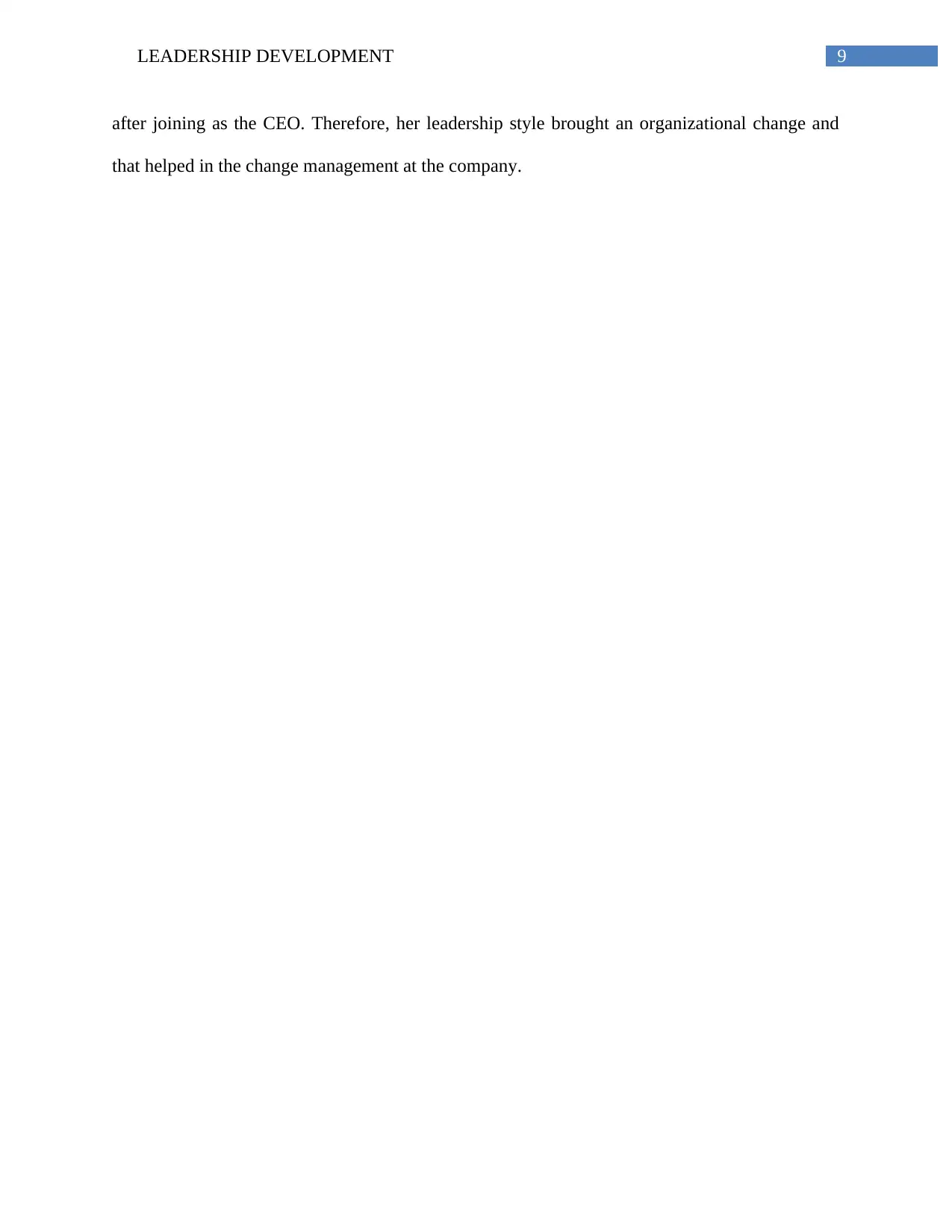
9LEADERSHIP DEVELOPMENT
after joining as the CEO. Therefore, her leadership style brought an organizational change and
that helped in the change management at the company.
after joining as the CEO. Therefore, her leadership style brought an organizational change and
that helped in the change management at the company.
Secure Best Marks with AI Grader
Need help grading? Try our AI Grader for instant feedback on your assignments.
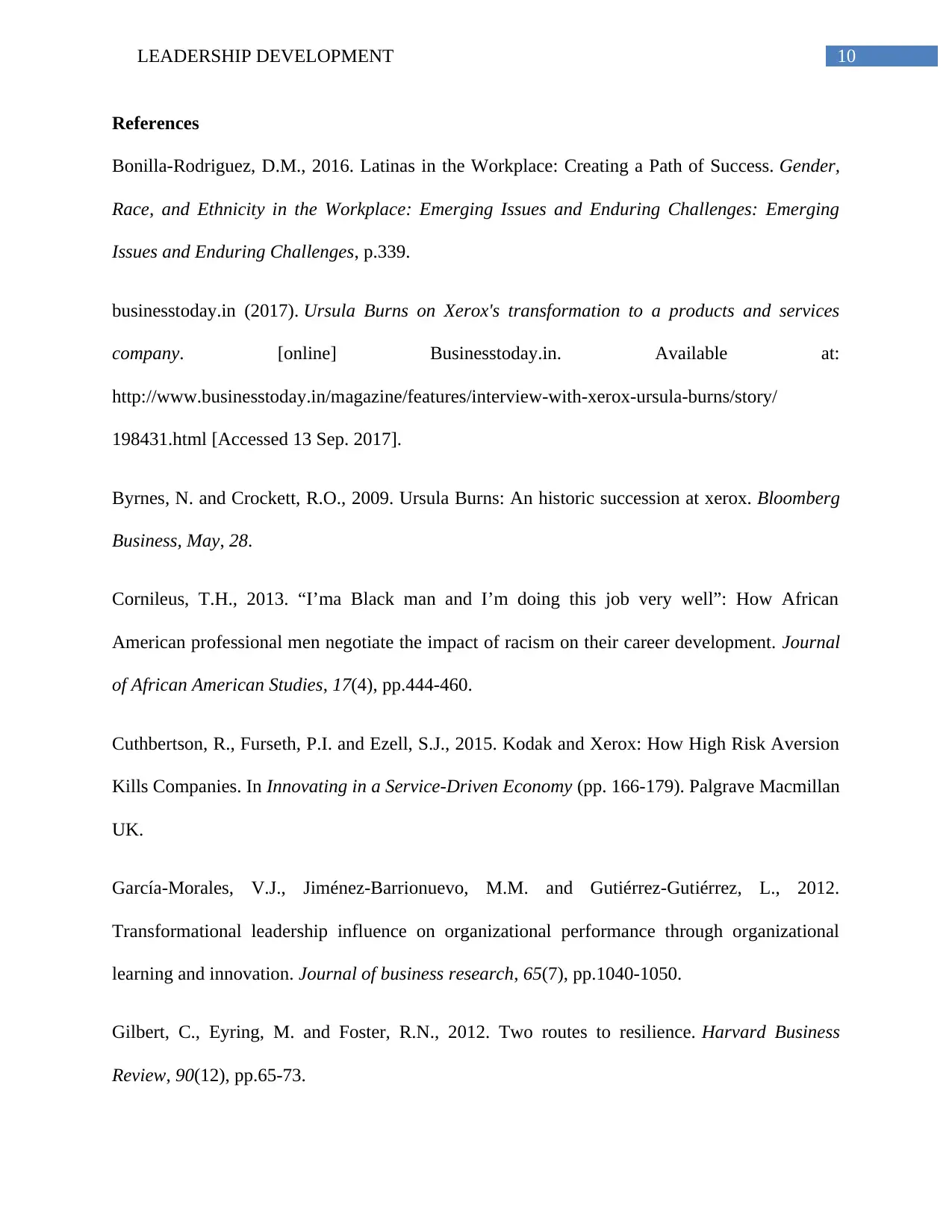
10LEADERSHIP DEVELOPMENT
References
Bonilla-Rodriguez, D.M., 2016. Latinas in the Workplace: Creating a Path of Success. Gender,
Race, and Ethnicity in the Workplace: Emerging Issues and Enduring Challenges: Emerging
Issues and Enduring Challenges, p.339.
businesstoday.in (2017). Ursula Burns on Xerox's transformation to a products and services
company. [online] Businesstoday.in. Available at:
http://www.businesstoday.in/magazine/features/interview-with-xerox-ursula-burns/story/
198431.html [Accessed 13 Sep. 2017].
Byrnes, N. and Crockett, R.O., 2009. Ursula Burns: An historic succession at xerox. Bloomberg
Business, May, 28.
Cornileus, T.H., 2013. “I’ma Black man and I’m doing this job very well”: How African
American professional men negotiate the impact of racism on their career development. Journal
of African American Studies, 17(4), pp.444-460.
Cuthbertson, R., Furseth, P.I. and Ezell, S.J., 2015. Kodak and Xerox: How High Risk Aversion
Kills Companies. In Innovating in a Service-Driven Economy (pp. 166-179). Palgrave Macmillan
UK.
García-Morales, V.J., Jiménez-Barrionuevo, M.M. and Gutiérrez-Gutiérrez, L., 2012.
Transformational leadership influence on organizational performance through organizational
learning and innovation. Journal of business research, 65(7), pp.1040-1050.
Gilbert, C., Eyring, M. and Foster, R.N., 2012. Two routes to resilience. Harvard Business
Review, 90(12), pp.65-73.
References
Bonilla-Rodriguez, D.M., 2016. Latinas in the Workplace: Creating a Path of Success. Gender,
Race, and Ethnicity in the Workplace: Emerging Issues and Enduring Challenges: Emerging
Issues and Enduring Challenges, p.339.
businesstoday.in (2017). Ursula Burns on Xerox's transformation to a products and services
company. [online] Businesstoday.in. Available at:
http://www.businesstoday.in/magazine/features/interview-with-xerox-ursula-burns/story/
198431.html [Accessed 13 Sep. 2017].
Byrnes, N. and Crockett, R.O., 2009. Ursula Burns: An historic succession at xerox. Bloomberg
Business, May, 28.
Cornileus, T.H., 2013. “I’ma Black man and I’m doing this job very well”: How African
American professional men negotiate the impact of racism on their career development. Journal
of African American Studies, 17(4), pp.444-460.
Cuthbertson, R., Furseth, P.I. and Ezell, S.J., 2015. Kodak and Xerox: How High Risk Aversion
Kills Companies. In Innovating in a Service-Driven Economy (pp. 166-179). Palgrave Macmillan
UK.
García-Morales, V.J., Jiménez-Barrionuevo, M.M. and Gutiérrez-Gutiérrez, L., 2012.
Transformational leadership influence on organizational performance through organizational
learning and innovation. Journal of business research, 65(7), pp.1040-1050.
Gilbert, C., Eyring, M. and Foster, R.N., 2012. Two routes to resilience. Harvard Business
Review, 90(12), pp.65-73.
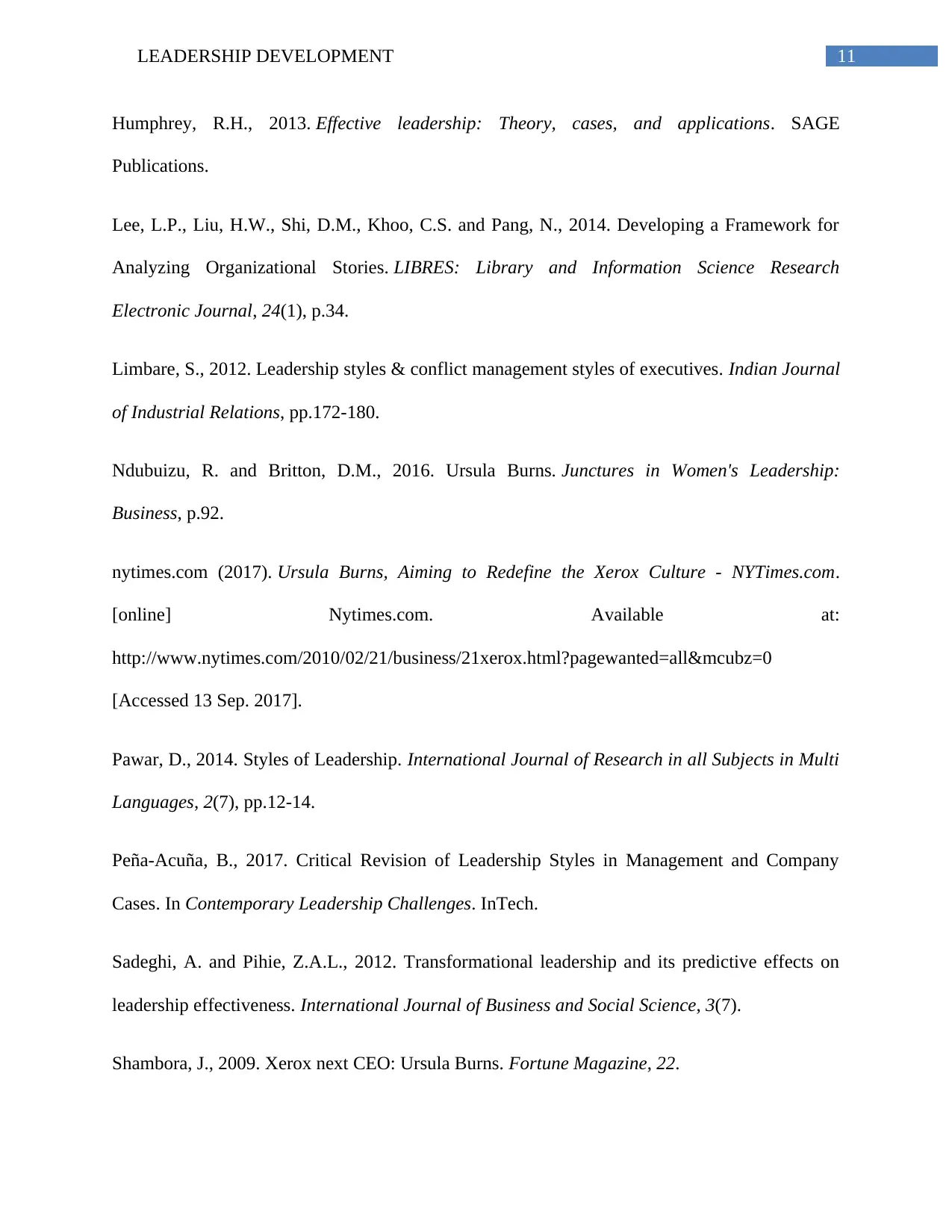
11LEADERSHIP DEVELOPMENT
Humphrey, R.H., 2013. Effective leadership: Theory, cases, and applications. SAGE
Publications.
Lee, L.P., Liu, H.W., Shi, D.M., Khoo, C.S. and Pang, N., 2014. Developing a Framework for
Analyzing Organizational Stories. LIBRES: Library and Information Science Research
Electronic Journal, 24(1), p.34.
Limbare, S., 2012. Leadership styles & conflict management styles of executives. Indian Journal
of Industrial Relations, pp.172-180.
Ndubuizu, R. and Britton, D.M., 2016. Ursula Burns. Junctures in Women's Leadership:
Business, p.92.
nytimes.com (2017). Ursula Burns, Aiming to Redefine the Xerox Culture - NYTimes.com.
[online] Nytimes.com. Available at:
http://www.nytimes.com/2010/02/21/business/21xerox.html?pagewanted=all&mcubz=0
[Accessed 13 Sep. 2017].
Pawar, D., 2014. Styles of Leadership. International Journal of Research in all Subjects in Multi
Languages, 2(7), pp.12-14.
Peña-Acuña, B., 2017. Critical Revision of Leadership Styles in Management and Company
Cases. In Contemporary Leadership Challenges. InTech.
Sadeghi, A. and Pihie, Z.A.L., 2012. Transformational leadership and its predictive effects on
leadership effectiveness. International Journal of Business and Social Science, 3(7).
Shambora, J., 2009. Xerox next CEO: Ursula Burns. Fortune Magazine, 22.
Humphrey, R.H., 2013. Effective leadership: Theory, cases, and applications. SAGE
Publications.
Lee, L.P., Liu, H.W., Shi, D.M., Khoo, C.S. and Pang, N., 2014. Developing a Framework for
Analyzing Organizational Stories. LIBRES: Library and Information Science Research
Electronic Journal, 24(1), p.34.
Limbare, S., 2012. Leadership styles & conflict management styles of executives. Indian Journal
of Industrial Relations, pp.172-180.
Ndubuizu, R. and Britton, D.M., 2016. Ursula Burns. Junctures in Women's Leadership:
Business, p.92.
nytimes.com (2017). Ursula Burns, Aiming to Redefine the Xerox Culture - NYTimes.com.
[online] Nytimes.com. Available at:
http://www.nytimes.com/2010/02/21/business/21xerox.html?pagewanted=all&mcubz=0
[Accessed 13 Sep. 2017].
Pawar, D., 2014. Styles of Leadership. International Journal of Research in all Subjects in Multi
Languages, 2(7), pp.12-14.
Peña-Acuña, B., 2017. Critical Revision of Leadership Styles in Management and Company
Cases. In Contemporary Leadership Challenges. InTech.
Sadeghi, A. and Pihie, Z.A.L., 2012. Transformational leadership and its predictive effects on
leadership effectiveness. International Journal of Business and Social Science, 3(7).
Shambora, J., 2009. Xerox next CEO: Ursula Burns. Fortune Magazine, 22.
1 out of 12
Your All-in-One AI-Powered Toolkit for Academic Success.
+13062052269
info@desklib.com
Available 24*7 on WhatsApp / Email
![[object Object]](/_next/static/media/star-bottom.7253800d.svg)
Unlock your academic potential
© 2024 | Zucol Services PVT LTD | All rights reserved.





